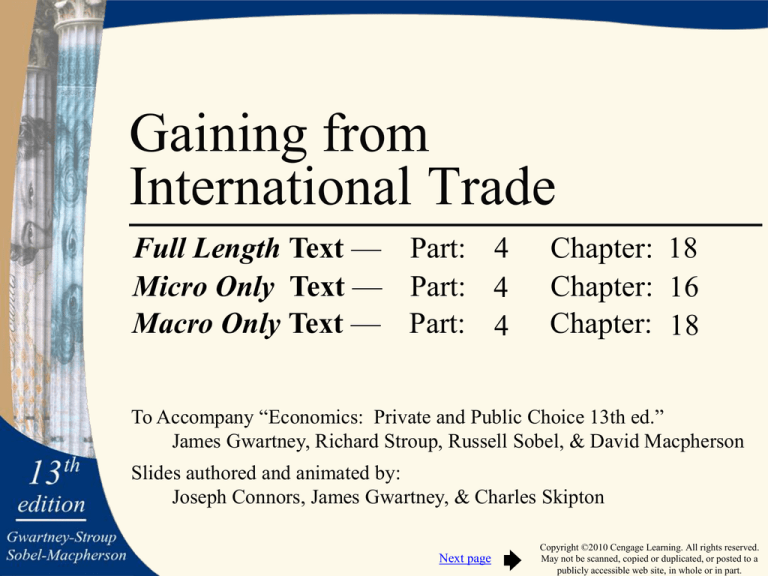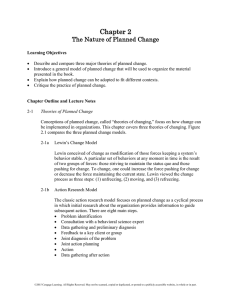
Gaining from
International Trade
Full Length Text — Part: 4
Micro Only Text — Part: 4
Macro Only Text — Part: 4
Chapter: 18
Chapter: 16
Chapter: 18
To Accompany “Economics: Private and Public Choice 13th ed.”
James Gwartney, Richard Stroup, Russell Sobel, & David Macpherson
Slides authored and animated by:
Joseph Connors, James Gwartney, & Charles Skipton
Next page
Copyright ©2010 Cengage Learning. All rights reserved.
May not be scanned, copied or duplicated, or posted to a
publicly accessible web site, in whole or in part.
The Trade Sector
of the United States
Jump to first page
Copyright ©2010 Cengage Learning. All rights reserved.
May not be scanned, copied or duplicated, or posted to a
publicly accessible web site, in whole or in part.
The Growth of the U.S. Trade Sector
• As is shown here, both exports and imports have grown
substantially as a share of the U.S. economy during the last
several decades. Their growth has accelerated since 1980.
• Reductions in transport and communication costs, as well
as lower trade barriers have contributed to this growth.
Imports
Exports
(% of GDP)
(% of GDP)
20
20
15
15
10
10
5
5
1960
1970
1980
1990
2000
2010 1960
1970
1980
1990
2000 2010
Source: http://www.economagic.com/. The figures are based on data for real imports, exports, and GDP.
Jump to first page
Copyright ©2010 Cengage Learning. All rights reserved.
May not be scanned, copied or duplicated, or posted to a
publicly accessible web site, in whole or in part.
Leading Trading Partners of the U.S.
–––––––– Percent of Total U.S. Trade, 2008 ––––––––
Canada
China
Mexico
Japan
Germany
United Kingdom
South Korea
France
Saudi Arabia
Venezuela
All other countries
17.5%
12.0%
10.8%
6.1%
4.5%
3.3%
2.4%
2.2%
2.0%
1.9%
37.2%
• Today, Canada, China, Mexico, and Japan are the leading
trading partners with the United States.
• The impact of international trade varies across industries.
In some industries, U.S. firms are able to compete quite
effectively, while in others they find it difficult to do so.
Jump to first page
Copyright ©2010 Cengage Learning. All rights reserved.
May not be scanned, copied or duplicated, or posted to a
publicly accessible web site, in whole or in part.
Gains from
Specialization and Trade
Jump to first page
Copyright ©2010 Cengage Learning. All rights reserved.
May not be scanned, copied or duplicated, or posted to a
publicly accessible web site, in whole or in part.
Gains from Trade: An Overview
• Most international trade is not between the
governments of different nations but rather
between the people and firms located in
different countries.
• Like other voluntary exchanges, international
trade occurs because both the buyer and the
seller expect to gain, and generally do.
• If both parties did not expect to gain, they
would not agree to the exchange.
• With international trade, a country’s residents
can gain by specializing in the production of
goods they can produce economically.
• They can sell those goods in the world market
and use the proceeds to import goods that
would be expensive to produce domestically.
Jump to first page
Copyright ©2010 Cengage Learning. All rights reserved.
May not be scanned, copied or duplicated, or posted to a
publicly accessible web site, in whole or in part.
Law of Comparative Advantage
• Law of Comparative Advantage:
A group of individuals, regions, or nations can
produce a larger joint output if each specializes
in the production of goods in which it is a lowopportunity cost producer and trades for goods
for which it is a high opportunity cost producer.
Jump to first page
Copyright ©2010 Cengage Learning. All rights reserved.
May not be scanned, copied or duplicated, or posted to a
publicly accessible web site, in whole or in part.
Gains from Specialization and Trade
• International trade leads to mutual gain
because it allows each country to specialize
more fully in the production of those things
that it does best according to the law of
comparative advantage.
• Trade makes it possible for each country to
use more of its resources to produce those
goods and services that it can produce at a
relatively low cost.
• With trade, it will be possible for the trading
partners to consume a bundle of goods that it
would be impossible for them to produce
domestically.
Jump to first page
Copyright ©2010 Cengage Learning. All rights reserved.
May not be scanned, copied or duplicated, or posted to a
publicly accessible web site, in whole or in part.
Gains from Specialization and Trade
• As long as relative production costs of two goods differ
between two countries—for example, U.S. and Japan—
gains from trade will be possible.
Output per worker day
Food Clothing
(1)
(2)
Country
United States
Japan
2
3
1
9
Change in total output
Potential change in output*
Food Clothing
(3)
(4)
+6
-3
+3
-3
+9
+6
* Change in output if US shifts 3 workers from clothing to food industry and if Japan shifts one from food to clothing.
• Columns (1) and (2) indicate the daily per worker output of
the food and clothing industry in the U.S. and Japan.
• If the U.S. moves 3 workers from clothing to food, it
produces 6 more units of food and only 3 fewer of clothing.
• If Japan moves 1 worker from food to clothing, it produces 9
more units of clothing and only 3 fewer of food.
• With such a reallocation of labor, the U.S. and Japan are able
to increase their aggregate output of both food and clothing.
Jump to first page
Copyright ©2010 Cengage Learning. All rights reserved.
May not be scanned, copied or duplicated, or posted to a
publicly accessible web site, in whole or in part.
PPC before Specialization and Trade
• Here we illustrate the daily production of the labor force of
both the US (200 million) and Japan (50 million) given the
production costs of food and clothing from the previous slide.
• In the absence of trade, consumption possibilities will be
restricted to points like US1 in the U.S. and J1 in Japan.
• Each of these points lies along the production possibilities
curve (PPC) of the respective nation.
Clothing
(million units)
United States
450
400
350
Production possibilities, U.S.
300
250
M
200
150
US1
100
50
N
Food
100 200 300 400 (million units)
Clothing
Japan
(million units)
450
R
375
Production possibilities, Japan
300
225
J1
150
75
Food
S
75
Jump to first page
150
225
300
450
(million
units)
Copyright ©2010 Cengage Learning. All rights reserved.
May not be scanned, copied or duplicated, or posted to a
publicly accessible web site, in whole or in part.
Trade Expands Consumption Possibilities
• Specialization and trade expand consumption possibilities.
• If the U.S. trades food for clothing (1-for-1), it can specialize
in the production of food and consume along the ON line
(rather than its original production-possibilities constraint, MN).
• Similarly, if Japan trades clothing for food (1-for-1), it can
specialize in the production of clothing and consume any
combination along the RT line (rather than its original, RS).
Clothing
United States
(million units)
450
400 O
350
300
250
M
200
150
US1
100
50
100
Clothing
450
Consumption possibilities
of U.S. with trade
Japan
(million units)
R
Consumption possibilities
of Japan with trade
375
300
225
J1
150
75
N
200
300
Food
400 (million units)
T
S
75
Jump to first page
150
225
300
450
Food
(million
units)
Copyright ©2010 Cengage Learning. All rights reserved.
May not be scanned, copied or duplicated, or posted to a
publicly accessible web site, in whole or in part.
Trade Expands Consumption Possibilities
• For example, with specialization and trade, the U.S. could
increase its consumption from US1 to US2, gaining 50 million
units of clothing and 100 million units of food.
• Simultaneously, Japan could increase consumption from
J1 to J2, a gain of 125 million units of food and 25 million
units of clothing.
Clothing
United States
(million units)
450
400 O
350
300
250
M
200
150
US1
100
50
Clothing
450
R
375
300
250
225
US2
J1
J2
150
75
N
S
Food
100
Japan
(million units)
200
300
400 (million units)
75
Jump to first page
150
200
225
T
300
450
Food
(million
units)
Copyright ©2010 Cengage Learning. All rights reserved.
May not be scanned, copied or duplicated, or posted to a
publicly accessible web site, in whole or in part.
Trade Expands Consumption Possibilities
• How exactly do the U.S. and Japan consume at US2 and J2?
• The U.S. produces 400 million units of food, consumes 200
million, and exports 200 million to Japan.
• Japan produces 450 million units of clothing, consumes 250
million, and exports 200 million to the U.S..
• Each consumes more than it could produce domestically.
Clothing
United States
(million units)
450
375
300
250
225
US imports
US2
Japan
(million units)
R
Japan exports
450
400 O
350
300
250
M
200
150
100
50
Clothing
J2
150
75
US exports
100
200
300
N
Food
400 (million units)
Japan imports
S 150
Jump to first page
200
225
T
300
450
Food
(million
units)
Copyright ©2010 Cengage Learning. All rights reserved.
May not be scanned, copied or duplicated, or posted to a
publicly accessible web site, in whole or in part.
International Trade
is a Key to Prosperity
• In addition to gains from specialization in
areas of comparative advantage, international
trade also leads to gains from:
• Economies of Scale:
International trade allows both domestic
producers and consumers to gain from
reductions in per-unit costs that often
accompany large-scale production,
marketing, and distribution.
• More Competitive Markets:
International trade promotes competition
in domestic markets and allows consumers
to purchase a wider variety of goods at
economical prices.
Jump to first page
Copyright ©2010 Cengage Learning. All rights reserved.
May not be scanned, copied or duplicated, or posted to a
publicly accessible web site, in whole or in part.
Supply, Demand,
and International Trade
Jump to first page
Copyright ©2010 Cengage Learning. All rights reserved.
May not be scanned, copied or duplicated, or posted to a
publicly accessible web site, in whole or in part.
U.S. Has a Comparative Advantage
• The price of soybeans and other internationally traded
commodities is determined by the forces of supply and
demand in the world market.
• If U.S. soybean producers were prohibited from selling to
foreigners, the domestic price would be Pn.
• Free trade permits U.S. soybean producers to sell Qp units
at the higher world price of Pw.
U.S. Market
Price
Pw
World Market
Sd
a
b
Sw
Price
Sw
Pw
c
Pn
Dw
Dd
Qc
Qn
Soybeans
Qp (bushels)
Jump to first page
Qw
Soybeans
(bushels)
Copyright ©2010 Cengage Learning. All rights reserved.
May not be scanned, copied or duplicated, or posted to a
publicly accessible web site, in whole or in part.
U.S. Has a Comparative Advantage
• At the world price of Pw, the quantity (Qp – Qc) is exported.
• Compared to the no-trade situation, the producers’ gain from
the higher price (Pw b c Pn) exceeds the cost imposed on
domestic consumers (Pw a c Pn) by the triangle (area) a b c.
U.S. Market
Price
Pw
World Market
Sd
a
b
Sw
Price
Sw
Pw
c
Pn
Dw
Dd
U.S. exports
Qc
Qn
Soybeans
Qp (bushels)
Jump to first page
Qw
Soybeans
(bushels)
Copyright ©2010 Cengage Learning. All rights reserved.
May not be scanned, copied or duplicated, or posted to a
publicly accessible web site, in whole or in part.
Foreigners Have
a Comparative Advantage
• Consider the international market for manufactured shoes.
• In the absence of trade, the domestic price would be Pn.
• Since many foreign producers have a comparative advantage
in the production of shoes, international trade leads to lower
prices Pw.
U.S. Market
World Market
Sd
Price
Price
Sw
Pn
a
Pw
Dd
Dw
Qn
Soybeans
(bushels)
Jump to first page
Qw
Soybeans
(bushels)
Copyright ©2010 Cengage Learning. All rights reserved.
May not be scanned, copied or duplicated, or posted to a
publicly accessible web site, in whole or in part.
Foreigners Have
a Comparative Advantage
• At the price Pw, U.S. consumers demand Qc units
of which (Qc – Qp) are imported.
• Compared to no trade, consumers gain Pn a b Pw,
while domestic producers lose Pn a c Pw.
• A net gain of a b c results.
U.S. Market
World Market
Sd
Price
Price
Sw
a
Pn
Pw
c
b
Pw
Sw
Dd
Dw
U.S. imports
Qp Q n Qc
Soybeans
(bushels)
Jump to first page
Qw
Soybeans
(bushels)
Copyright ©2010 Cengage Learning. All rights reserved.
May not be scanned, copied or duplicated, or posted to a
publicly accessible web site, in whole or in part.
Summary:
Supply, Demand, & Gains from Trade
• International trade and specialization result in
lower prices (and more domestic consumption) for
imported products and higher prices (and less
domestic consumption) for exported products.
• Trade makes it possible for domestic
producers to obtain higher prices for the
items they export and for domestic consumers
to buy imported items at lower prices.
• As a result, the residents of each nation are
able to focus more of their resources on the
things they do best (produce at a low cost),
while trading for those goods for which
they are high opportunity cost producers.
Jump to first page
Copyright ©2010 Cengage Learning. All rights reserved.
May not be scanned, copied or duplicated, or posted to a
publicly accessible web site, in whole or in part.
Questions for Thought:
1. State the law of comparative advantage in your
own words.
2. Under what conditions can a nation gain from
international trade?
3. Do you think the 50 states of the United States
would be better off if each imposed trade
barriers limiting trade across state boundaries?
Do you think the countries of North and South
America would be better off if there were no
trade restrictions limiting trade across national
boundaries? Explain your response.
Jump to first page
Copyright ©2010 Cengage Learning. All rights reserved.
May not be scanned, copied or duplicated, or posted to a
publicly accessible web site, in whole or in part.
Questions for Thought:
4. Are the following statements true or false?
a. “If a nation is going to produce its maximum
potential output and achieve full employment,
it must impose tariffs and quotas in order to
protect domestic industries and jobs.”
b. “Everyone benefits when trade barriers (for
example, tariffs and quotas) are removed.”
c. “When a country trades for those things for
which it is a high cost producer, it will be
able to use more of its resources to produce
items it can produce at a low cost.”
Jump to first page
Copyright ©2010 Cengage Learning. All rights reserved.
May not be scanned, copied or duplicated, or posted to a
publicly accessible web site, in whole or in part.
The Economics of
Trade Restrictions
Jump to first page
Copyright ©2010 Cengage Learning. All rights reserved.
May not be scanned, copied or duplicated, or posted to a
publicly accessible web site, in whole or in part.
U.S. Tariff Rates: 1890 to the Present
–––––––– U.S. Average Tariff Rate ––––––––
(Duties collected as a share of dutiable imports)
60%
50%
40%
30%
20%
4.0%
10%
1890
1910
1930
1950
1970
1990
2008
• The average tariff rate (taxes levied upon imports) for the
United States (since 1890) is illustrated above.
Jump to first page
Copyright ©2010 Cengage Learning. All rights reserved.
May not be scanned, copied or duplicated, or posted to a
publicly accessible web site, in whole or in part.
Trade Restrictions: Impact of a Tariff
• Consider a tariff on auto imports.
• Without a tariff, the world price
Price
of autos is Pw. At Pw consumers
SDomestic
in the U.S. purchase Q1 units …
Qd1 from U.S. producers and …
Q1 – Qd1 from foreign producers.
• A tariff t makes it more costly for
Imports after tariff
Americans to purchase autos from
abroad. U.S. prices rise to Pw+ t Pw+ t
and purchases fall from Q1 to Q2.
Tariff = t
S
U T V
• U.S. purchases from domestic
Pw
producers rise from Qd1 to Qd2 …
Initial imports
imports fall to Q2 – Qd2.
DDomestic
• Producers gain area S …the tariff
generates T tax revenues … areas
Quantity
U & V are deadweight losses from
(automobiles)
Qd1 Qd2 Q2 Q1
reduction in allocative efficiency.
• Consumers lose S + U + T + V in
the form of higher prices and a
Copyright ©2010 Cengage Learning. All rights reserved.
reduction of consumer surplus.
May not be scanned, copied or duplicated, or posted to a
Jump to first page
publicly accessible web site, in whole or in part.
Trade Restrictions: Impact of a Quota
• Consider a quota on peanuts.
• Without trade restraints, Pw (the
world price of peanuts) would be
the domestic price. At Pw U.S.
consumers would purchase Q1 …
Qd1 from U.S. producers and …
Q1 – Qd1 imported from abroad.
• A quota of Q2 – Qd2 imports
pushes the U.S. price up to P2.
• While total U.S. purchases fall
(from Q1 to Q2), those from U.S.
producers rise (from Qd1 to Qd2)
and … imports fall to Q2 – Qd2.
• U.S. producers gain area S. Area
T goes to foreign producers with
permits to import into the U.S.
•U & V are deadweight losses.
Consumers lose S + U + T + V in
the form of higher prices and a
reduction of consumer surplus.
Price
SDomestic
Import quota:
Q2 – Qd2
P2
Pw
S
U
T
V
Initial imports
DDomestic
Qd1 Qd2 Q2 Q1
Quantity
(peanuts)
Note: The government derives no
additional revenue from quotas.
Jump to first page
Copyright ©2010 Cengage Learning. All rights reserved.
May not be scanned, copied or duplicated, or posted to a
publicly accessible web site, in whole or in part.
Why do Nations Adopt
Trade Restrictions?
Jump to first page
Copyright ©2010 Cengage Learning. All rights reserved.
May not be scanned, copied or duplicated, or posted to a
publicly accessible web site, in whole or in part.
Arguments Used to
Justify Trade Restrictions
• Proponents of trade restrictions often
use the following arguments in an effort
to justify their position:
• National defense argument:
domestic industry is needed for national
defense purposes.
• Dumping:
the sale of goods abroad at a price below the
cost of production (and below the domestic
market price of the exporting nation).
• Dumping is illegal under U.S. law.
• Infant Industry argument:
new industry needs protection so it can mature.
Jump to first page
Copyright ©2010 Cengage Learning. All rights reserved.
May not be scanned, copied or duplicated, or posted to a
publicly accessible web site, in whole or in part.
A Few Additional Issues
Related to Dumping
• When considering the merits of anti-dumping
restrictions, remember that:
• Firms with large inventories (either domestic
or abroad) may find it in their interest to offer
goods at prices below their original cost of
production.
• Domestic firms are legally allowed to engage
in this practice.
• Lower prices benefit domestic consumers.
Jump to first page
Copyright ©2010 Cengage Learning. All rights reserved.
May not be scanned, copied or duplicated, or posted to a
publicly accessible web site, in whole or in part.
Trade Restrictions are
a Special Interest Issue
• “Protectionism is a politician's delight because
it delivers visible benefits to the protected
parties while imposing the costs as a hidden
tax on the public.” —Murray L. Weidenbaum
• The special interest effect provides the primary
explanation for trade restrictions.
• Trade restrictions almost always provide
highly visible, concentrated benefits for a
small group of people, while imposing widely
dispersed costs that are often difficult to
identify on the general citizenry.
• Politicians have a strong incentive to favor
special interest issues, even if they conflict
with economic efficiency.
Jump to first page
Copyright ©2010 Cengage Learning. All rights reserved.
May not be scanned, copied or duplicated, or posted to a
publicly accessible web site, in whole or in part.
Trade Barriers and
Popular Trade Fallacies
Jump to first page
Copyright ©2010 Cengage Learning. All rights reserved.
May not be scanned, copied or duplicated, or posted to a
publicly accessible web site, in whole or in part.
Trade Fallacies
• Trade fallacies abound because people
often fail to consider the secondary effects.
• Key elements of international trade are
often linked – you cannot change one
element without changing the other.
• This is the case with imports and exports;
policies that restrain imports also restrain
exports.
Jump to first page
Copyright ©2010 Cengage Learning. All rights reserved.
May not be scanned, copied or duplicated, or posted to a
publicly accessible web site, in whole or in part.
Trade Fallacies
• Trade fallacy 1:
“Trade restrictions that limit imports save jobs
for Americans.”
• This view is false because if foreigners sell
less to us they will have fewer dollars with
which to buy things from us. Thus, restraints
on imports will also restrain exports.
• Trade restrictions do not “save” jobs; they
merely reshuffle them. Jobs “saved” in
protected industries will be offset by jobs
“lost” in export industries.
• As the result of trade restrictions, fewer
Americans are employed in areas where we
have a comparative advantage.
Jump to first page
Copyright ©2010 Cengage Learning. All rights reserved.
May not be scanned, copied or duplicated, or posted to a
publicly accessible web site, in whole or in part.
Trade Fallacies
• Trade fallacy 2:
"Free trade with low-wage countries, such as
Mexico and China, will reduce the wages of
Americans."
• Both high- and low-wage countries will gain
when they are able to focus more of their
resources on those productive activities that
they do well.
• The key to this issue is how will U.S.
resources be used. If a low-wage country can
supply a good cheaper than we can produce
it, the U.S. can gain by purchasing the good
from the low-wage country and using its
resources to produce other goods for which it
has a comparative advantage.
Jump to first page
Copyright ©2010 Cengage Learning. All rights reserved.
May not be scanned, copied or duplicated, or posted to a
publicly accessible web site, in whole or in part.
The Changing Nature
of Global Trade
Jump to first page
Copyright ©2010 Cengage Learning. All rights reserved.
May not be scanned, copied or duplicated, or posted to a
publicly accessible web site, in whole or in part.
Trade Openness, Income, and Growth
• Propelled by technological advancements,
lower transport costs, and more liberal trade
policies, international trade has approximately
doubled as a share of the world economy
since 1970.
• International trade helps people achieve
higher income levels.
Jump to first page
Copyright ©2010 Cengage Learning. All rights reserved.
May not be scanned, copied or duplicated, or posted to a
publicly accessible web site, in whole or in part.
Trade Openness, Income, and Growth
10 Most Open
Economies,
1980-2002
Hong Kong
Singapore
Bahrain
Belgium
Malaysia
Luxembourg
Netherlands
Taiwan
Ireland
Australia
Average:
TOI
2005 GDP Growth rate
per capita 1980-2005
10.0
9.9
8.6
8.6
8.6
8.5
8.4
8.4
8.1
7.9
8.7
$ 30,989
$ 26,390
$ 19,112
$ 28,575
$ 9,681
$ 53,583
$ 29,078
$ 20,868
$ 34,256
$ 29,981
$ 28,251
3.9 %
4.3 %
1.0 %
1.7 %
3.6 %
3.7 %
1.6 %
5.1 %
4.5 %
1.9 %
3.1 %
10 Least Open
Economies,
1980-2002
India
Tanzania
Egypt
Pakistan
Syria
Algeria
Sierra Leone
Burundi
Iran
Bangladesh
Average:
TOI
4.3
4.1
4.1
3.9
3.8
3.4
3.4
3.0
2.9
2.5
3.5
2005 GDP Growth rate
per capita 1980-2005
$ 3,072
$ 662
$ 3,858
$ 2,109
$ 3,388
$ 6,283
$ 717
$ 622
$ 7,089
$ 1,827
$ 2,963
4.0 %
2.3 %
2.5 %
2.4 %
0.6 %
0.5 %
- 1.1 %
- 1.0 %
1.1 %
2.2 %
1.4 %
Sources: TOI data are from Charles Skipton, The Measurement of Trade Openness. Doctoral Dissertation, Florida State University, 2003.
The per capita GDP and growth data are from The World Bank, World Development Indicators, CD-ROM, 2004.
• The income levels and growth rates of the ten most and
ten least open economies (as measured by the Trade
Openness Index – TOI) are displayed above.
• Note that more open economies both achieved higher
income levels and grew more rapidly.
Jump to first page
Copyright ©2010 Cengage Learning. All rights reserved.
May not be scanned, copied or duplicated, or posted to a
publicly accessible web site, in whole or in part.
Trade Openness, Income, and Growth
• Countries like Hong Kong and Singapore
that have persistently followed more open
trade policies, have achieved higher income
levels, and grown more rapidly than more
closed economies.
• During the last two decades, trade restrictions
have declined sharply, particularly in less
developed economies.
• Following the passage of NAFTA, U.S. trade
with both Canada and Mexico grew rapidly.
• The U.S. economy performed impressively, as
the size of the trade sector grew during
the 1990s.
Jump to first page
Copyright ©2010 Cengage Learning. All rights reserved.
May not be scanned, copied or duplicated, or posted to a
publicly accessible web site, in whole or in part.
U.S. Trade with Canada and Mexico
–––––––– U.S. Trade with Canada and Mexico ––––––––
6%
(Exports and Imports together as a share of GDP)
5%
Canada
4%
3%
Mexico
2%
1%
1980
1985
1990
1995
2000
2005
2008
• Measured as a share of GDP, U.S. trade with both Canada
and Mexico has increased sharply as a result
of NAFTA during the last 18 years.
Jump to first page
Copyright ©2010 Cengage Learning. All rights reserved.
May not be scanned, copied or duplicated, or posted to a
publicly accessible web site, in whole or in part.
Trade Openness, Income, and Growth
• Today, less developed countries are often at
the forefront of those pushing for greater
trade openness, while high-income countries
often impose restrictions in order to protect
various domestic industrial interests and
preserve their farm subsidy programs.
Jump to first page
Copyright ©2010 Cengage Learning. All rights reserved.
May not be scanned, copied or duplicated, or posted to a
publicly accessible web site, in whole or in part.
Questions for Thought:
1. “If the revenue collected by the government is
taken into account, a tariff has no net impact
on the welfare of a society.”
-- Is this statement true?
2. Politicians have a strong incentive to support
restrictions that limit international trade
because
a. trade restrictions generally benefit all, or
nearly all, voters.
b. trade restrictions generally provide highly
visible, concentrated benefits for a relatively
small number of people while imposing hardto-identify-costs on others.
Jump to first page
Copyright ©2010 Cengage Learning. All rights reserved.
May not be scanned, copied or duplicated, or posted to a
publicly accessible web site, in whole or in part.
Questions for Thought:
3. The imposition of tariffs, quotas, & other trade
barriers are often referred to as protectionist
policies. Who is being protected? What are
they being protected from?
4. “Exports are good. They create jobs and help
make America prosperous. On the other hand,
imports destroy jobs and reduce our standard
of living.” Do you agree or disagree?
5. “Policies that reduce the volume of imports
will also reduce the volume of exports.”
-- Is this statement true?
Jump to first page
Copyright ©2010 Cengage Learning. All rights reserved.
May not be scanned, copied or duplicated, or posted to a
publicly accessible web site, in whole or in part.
Questions for Thought:
6. In 2002, the Bush administration imposed
tariffs of up to 25% on imported steel
products. This action
a. reduced the supply of steel in the domestic
market and led to higher steel prices.
b. increased U.S. employment because it saved
jobs in the steel industry.
c. reduced employment in the U.S. steel
container industry because the higher steel
prices made it more difficult for them to
compete with foreign rivals.
d. helped George Bush carry the state of Ohio in
the 2004 presidential election.
7. Why would political officials want to prohibit
their citizens from trading with foreigners?
Jump to first page
Copyright ©2010 Cengage Learning. All rights reserved.
May not be scanned, copied or duplicated, or posted to a
publicly accessible web site, in whole or in part.
End
Chapter 18
Jump to first page
Copyright ©2010 Cengage Learning. All rights reserved.
May not be scanned, copied or duplicated, or posted to a
publicly accessible web site, in whole or in part.







